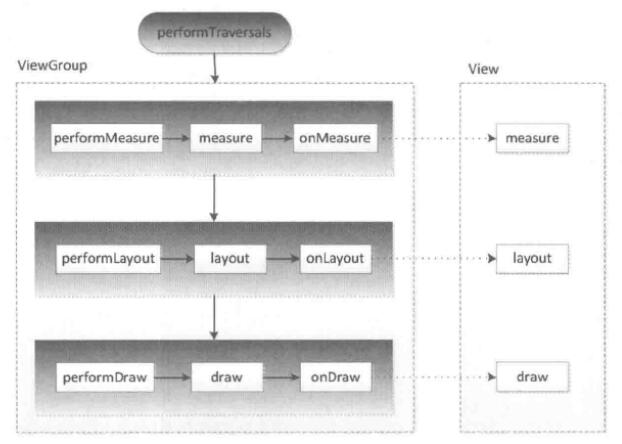内容:view源码分析
基础
1.ViewRoot
- ViewRoot对应ViewRootimpl类,连接WindowManager和DecorView。
- ActivityThread中,当Activity对象创建完毕,DecorView添加到Window中,同时创建ViewRootimpl与DecorView建立关联。
- View绘制流程从ViewRoot的performTraversals方法开始,三大流程由此完成。
- measure决定view宽高,measure完成后,通过getMeasuredWidth和getMeasuredHeight来获取测量后的宽高。
- Layout决定四个定点的坐标和实际view的宽高,通过gettop、getBottom、getLeft、getRight获取四个顶点位置,并通过getWidth和getHeight获取最终的宽高。
- Draw决定view的显示,通过draw方法呈现。
2.DecorView
顶级view本质为FrameLayout,内部包含竖直LinearLayout,上部标题栏,下部内容栏;Activity中setContentView所设置的布局文件其实是加到内容栏中,内容id为content,得到content代码:ViewGroup content = (ViewGroup )findViewById(android.R.id.content).
得到View代码:content.getChildAt(0).View层事件都经过DecorView
3.MeasureSpec
- 测量过程中,系统将View的LayoutParams根据父容器的规则转换成对应的MeasureSpec,根据MeasureSpec测量View的宽高(非最终宽高)。
- MeasureSpec代表32位int值,高2位代表SpecMode(测量模式),低30位代表SpecSize(测量模式下的规格大小),SpecMode和SpecSize打包为MeasureSpec,反之为解包,返回值为int.
MeasureSpec源码:
/**
*一个measurespec封装布局要求由父母传给孩子。
* 每个measurespec表示无论是宽度或高度的要求。
* 一个measurespec包括大小和模式。
* measurespecs是int型对象分配实施减少。
这个类提供了打包和解包的大小
*/
public static class MeasureSpec {
private static final int MODE_SHIFT = 30;
private static final int MODE_MASK = 0x3 << MODE_SHIFT;
/** @hide */
@IntDef({UNSPECIFIED, EXACTLY, AT_MOST})
@Retention(RetentionPolicy.SOURCE)
public @interface MeasureSpecMode {}
public static final int UNSPECIFIED = 0 << MODE_SHIFT;
public static final int EXACTLY = 1 << MODE_SHIFT;
public static final int AT_MOST = 2 << MODE_SHIFT;
/**
* 根据提供的大小和模式创建度量规范。
* @param size 测量规范的大小
* @param mode 测量规范的模式
* @return 基于尺寸和模式的测量规范
*/
public static int makeMeasureSpec(@IntRange(from = 0, to = (1 << MeasureSpec.MODE_SHIFT) - 1) int size,
@MeasureSpecMode int mode) {
if (sUseBrokenMakeMeasureSpec) {
return size + mode;
} else {
return (size & ~MODE_MASK) | (mode & MODE_MASK);
}
}
/**
* 用于兼容系统小部件和旧应用程序
*/
public static int makeSafeMeasureSpec(int size, int mode) {
if (sUseZeroUnspecifiedMeasureSpec && mode == UNSPECIFIED) {
return 0;
}
return makeMeasureSpec(size, mode);
}
/**
* 从所提供的测量规范中提取模式。
*UNSPECIFIED、AT_MOST、EXACTLY
*/
@MeasureSpecMode
public static int getMode(int measureSpec) {
//noinspection ResourceType
return (measureSpec & MODE_MASK);
}
/**
* 从提供的度量规范中提取大小。
*/
public static int getSize(int measureSpec) {
return (measureSpec & ~MODE_MASK);
}
static int adjust(int measureSpec, int delta) {
final int mode = getMode(measureSpec);
int size = getSize(measureSpec);
if (mode == UNSPECIFIED) {
// No need to adjust size for UNSPECIFIED mode.
return makeMeasureSpec(size, UNSPECIFIED);
}
size += delta;
if (size < 0) {
Log.e(VIEW_LOG_TAG, "MeasureSpec.adjust: new size would be negative! (" + size +
") spec: " + toString(measureSpec) + " delta: " + delta);
size = 0;
}
return makeMeasureSpec(size, mode);
}
/**
* 返回指定度量规范的字符串表示形式。
*
* @param measureSpec 转换为字符串的度量规范
* @return 以下格式的字符串:“measurespec:模式大小”
*/
public static String toString(int measureSpec) {
int mode = getMode(measureSpec);
int size = getSize(measureSpec);
StringBuilder sb = new StringBuilder("MeasureSpec: ");
if (mode == UNSPECIFIED)
sb.append("UNSPECIFIED ");
else if (mode == EXACTLY)
sb.append("EXACTLY ");
else if (mode == AT_MOST)
sb.append("AT_MOST ");
else
sb.append(mode).append(" ");
sb.append(size);
return sb.toString();
}
}
- SpecMode有三类:
UNSPECIFIED:父容器不对view限制,用于系统内部,表示一种测量状态。
EXACTLY:父容器已经检测出view的精确大小,view最终大小就是
SpecSize所指定的值,对应于LayoutParams中的match_parent和具体数值两种模式。
AT_MOST:父容器指定一个可用大小即SpecSize,View大小不能大于这个值。对应LayoutParams中的wrap_content.
4.MeasureSpec和LayoutParams对应关系
- 正常情况下我们使用View指定MeasureSpec;
- 对于DecorView,其MeasureSpec由窗口的尺寸和其自身的LayoutParams共同决定;
- 对于普通View,其MeasureSpec由父容器的MeasureSpec和自身的LayoutParams共同决定,onMeasure中可以确定View的测量宽高
- 关于DecorView的源码没有找到。DecorView的MeasureSpec遵守的规则,根据LayoutParams的宽高参数划分:
LayoutParams.MATCH_PARENT:精确模式,大小就是窗口的大小;
LayoutParams.WRAP_CONTENT:最大模式,大小不定,但是不能超过窗口大小;
固定大小:精确模式,大小为LayoutParams中指定大小; - 普通view的measure过程由ViewGroup传递来,看下ViewGroup的measureChildWithMargins源码:
protected void measureChildWithMargins(View child,
int parentWidthMeasureSpec, int widthUsed,
int parentHeightMeasureSpec, int heightUsed) {
final MarginLayoutParams lp = (MarginLayoutParams) child.getLayoutParams();
final int childWidthMeasureSpec = getChildMeasureSpec(parentWidthMeasureSpec,
mPaddingLeft + mPaddingRight + lp.leftMargin + lp.rightMargin
+ widthUsed, lp.width);
final int childHeightMeasureSpec = getChildMeasureSpec(parentHeightMeasureSpec,
mPaddingTop + mPaddingBottom + lp.topMargin + lp.bottomMargin
+ heightUsed, lp.height);
child.measure(childWidthMeasureSpec, childHeightMeasureSpec);
}
上述方法会对子元素进行measure,之前会先通过childWidthMeasureSpec方法来得到子元素的MeasureSpec。
- 子元素的MeasureSpec的创建与父容器的MeasureSpec和子元素的LayoutParams有关;还和view的margin及padding有关
看下ViewGroup的getChildMeasureSpec源码:
public static int getChildMeasureSpec(int spec, int padding, int childDimension) {
int specMode = MeasureSpec.getMode(spec);
int specSize = MeasureSpec.getSize(spec);
int size = Math.max(0, specSize - padding);
int resultSize = 0;
int resultMode = 0;
switch (specMode) {
// Parent has imposed an exact size on us
case MeasureSpec.EXACTLY:
if (childDimension >= 0) {
resultSize = childDimension;
resultMode = MeasureSpec.EXACTLY;
} else if (childDimension == LayoutParams.MATCH_PARENT) {
// Child wants to be our size. So be it.
resultSize = size;
resultMode = MeasureSpec.EXACTLY;
} else if (childDimension == LayoutParams.WRAP_CONTENT) {
// Child wants to determine its own size. It can't be
// bigger than us.
resultSize = size;
resultMode = MeasureSpec.AT_MOST;
}
break;
// Parent has imposed a maximum size on us
case MeasureSpec.AT_MOST:
if (childDimension >= 0) {
// Child wants a specific size... so be it
resultSize = childDimension;
resultMode = MeasureSpec.EXACTLY;
} else if (childDimension == LayoutParams.MATCH_PARENT) {
// Child wants to be our size, but our size is not fixed.
// Constrain child to not be bigger than us.
resultSize = size;
resultMode = MeasureSpec.AT_MOST;
} else if (childDimension == LayoutParams.WRAP_CONTENT) {
// Child wants to determine its own size. It can't be
// bigger than us.
resultSize = size;
resultMode = MeasureSpec.AT_MOST;
}
break;
// Parent asked to see how big we want to be
case MeasureSpec.UNSPECIFIED:
if (childDimension >= 0) {
// Child wants a specific size... let him have it
resultSize = childDimension;
resultMode = MeasureSpec.EXACTLY;
} else if (childDimension == LayoutParams.MATCH_PARENT) {
// Child wants to be our size... find out how big it should
// be
resultSize = View.sUseZeroUnspecifiedMeasureSpec ? 0 : size;
resultMode = MeasureSpec.UNSPECIFIED;
} else if (childDimension == LayoutParams.WRAP_CONTENT) {
// Child wants to determine its own size.... find out how
// big it should be
resultSize = View.sUseZeroUnspecifiedMeasureSpec ? 0 : size;
resultMode = MeasureSpec.UNSPECIFIED;
}
break;
}
//noinspection ResourceType
return MeasureSpec.makeMeasureSpec(resultSize, resultMode);
}
根据父容器的MeasureSpec同时结合View本身的LayoutParams来确定子元素的MeasureSpec;padding是指父容器中已占用的空间大小,因此子元素可用大小为父容器大小减去padding.
- 针对不同的父容器和view本身不同的LayoutParams,View可以有多种MeasureSpec。
- 对表格进行解释:
当View采用固定宽高的时候,不管父容器的MeasureSpec是什么,View的MeasureSpec都是精确模式,并且其大小遵循LayoutParams中的大小。
当View的宽高是match_parent时,如果父容器的模式是精准模式,那么View也是精准模式并且其大小是父容器的剩余空间;如果父容器是最大模式,那么View也是最大模式并且其大小不会超过父容器的剩余空间。
当View的宽高是wrap_content时,不管父容器的模式是精准还是最大化,View的模式总是最大化,并且大小不能超过父容器的剩余空间。
UNSPECIFIED用于系统内部不需要关注。

